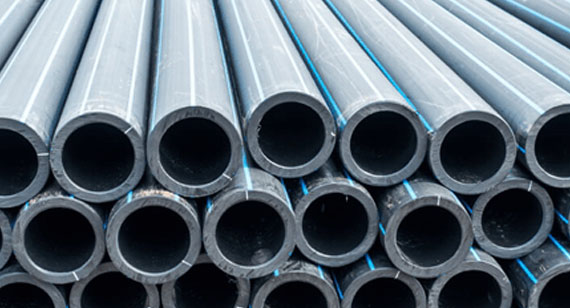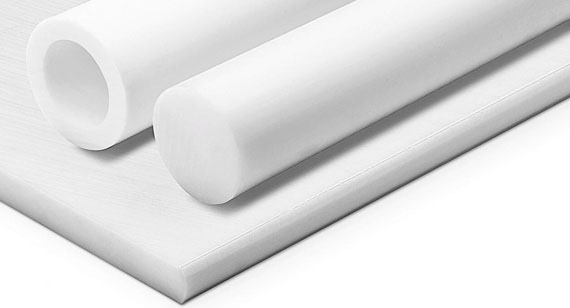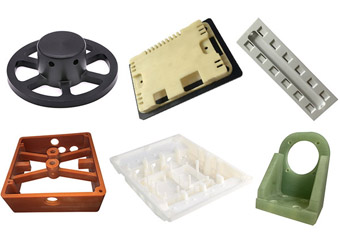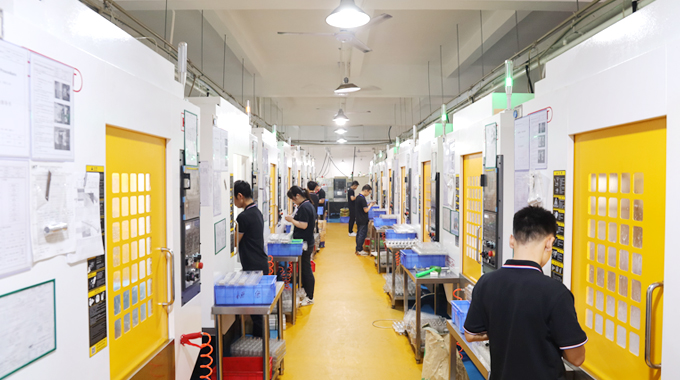14 years one-stop China custom CNC machining parts factory
 999 |
Published by VMT at May 20 2025 | Reading Time:About 5 minutes
999 |
Published by VMT at May 20 2025 | Reading Time:About 5 minutes
In the ever-evolving landscape of materials engineering, selecting the right plastic for manufacturing applications can be daunting. With numerous options available, understanding the unique properties and applications of each material is crucial.
Choosing an unsuitable material can lead to product failures, increased costs, and compromised safety. For instance, using a plastic that lacks chemical resistance in a corrosive environment can result in rapid degradation and potential hazards.
High-Density Polyethylene (HDPE) emerges as a reliable choice, offering a combination of strength, durability, and versatility. This article delves into the definition, properties, applications, advantages, and disadvantages of HDPE, providing a comprehensive understanding to aid in material selection.
High-Density Polyethylene (HDPE) is a thermoplastic polymer known for its high strength-to-density ratio, chemical resistance, and versatility. Commonly used in applications ranging from piping systems to food containers, HDPE's properties make it suitable for various industries, including construction, healthcare, and consumer goods.
To fully appreciate HDPE's role in modern manufacturing, it's essential to explore its fundamental characteristics, production methods, and the myriad ways it contributes to various industries.
Why Understanding HDPE Matters in Modern Manufacturing
Choosing the right material for CNC plastic machining can be confusing. With so many options—PVC, ABS, PEEK, PTFE—each with unique advantages, manufacturers often struggle to balance cost, durability, and performance.
Selecting the wrong plastic can lead to premature wear, product failures, or unnecessary machining expenses, especially in industries requiring chemical resistance or impact tolerance.
High-density polyethylene (HDPE) solves this by offering excellent strength-to-weight ratio, machinability, chemical resistance, and cost-effectiveness—making it one of the most trusted materials in plastic CNC machining services today.
To understand why HDPE is such a popular choice in plastic CNC machining, it’s essential to explore its structure, physical properties, and how it compares to other materials used in CNC machining factories. In the following sections, we’ll break down everything from HDPE's chemical makeup to its industrial applications—and why it could be the best choice for your next CNC project.
For more on plastic CNC machining parts, check out our guide on how different plastics perform under CNC processing or explore HDPE vs. LDPE material comparisons.
High-density polyethylene (HDPE) is a thermoplastic polymer made from the monomer ethylene. It is characterized by a linear molecular structure with minimal branching, which allows HDPE to pack tightly during crystallization, resulting in a dense, strong, and rigid plastic. HDPE is part of the polyethylene family and is typically marked as #2 plastic in recycling codes.
HDPE is widely used in plastic CNC machining parts because of its outstanding mechanical strength, machinability, impact resistance, and corrosion resistance. These properties make it ideal for machining a wide range of products—from fluid tanks and cutting boards to medical trays, insulators, and food-safe containers. CNC machining factories often prefer HDPE for both prototyping and production due to its ease of shaping, low moisture absorption, and chemical inertness.
One of the standout benefits of HDPE is its recyclability and environmental resistance, which enables it to perform well in both indoor and outdoor conditions. Whether used for marine components, medical equipment, or industrial-grade piping, HDPE combines performance and versatility in a lightweight package—making it a top-tier choice in CNC machining services.
Key Properties of HDPE:
These properties contribute to HDPE's widespread use in products like plastic bottles, corrosion-resistant piping, geomembranes, and plastic lumber.

Basic Information Table: High-Density Polyethylene (HDPE)
| Category |
Details |
| Common Names |
HDPE, High-Density Polyethylene (PEHD), Alkane, Polyethylene, #2 Plastic |
| Density |
0.958 g/cm³ (average) |
| Structure |
Linear |
| Material Properties |
- High strength-to-density ratio - Excellent impact resistance - Outstanding chemical resistance - Recyclable - High melting point - Easy to form and process |
This table helps your readers quickly understand the key identifiers and core features of HDPE, especially when comparing materials for HDPE CNC machining parts or other plastic CNC machining services.
High-density polyethylene (HDPE) is made through a controlled polymerization process that transforms ethylene—a gas derived from natural gas or crude oil—into a strong, durable plastic. The process involves specific catalysts and conditions that affect the structure, density, and final properties of the polymer. Here’s how it works:
1. Ethylene Polymerization
The base material for HDPE is ethylene (C₂H₄), a hydrocarbon gas. This ethylene is polymerized using either:
These catalysts control the growth of polymer chains, ensuring a linear molecular structure with minimal branching. This linearity is what gives HDPE its high density and strength compared to low-density polyethylene (LDPE), which has more branching.
2. Process Types
HDPE can be produced using several different polymerization techniques, including:
Each method affects the physical and mechanical properties of the final HDPE resin, such as molecular weight distribution and crystallinity.
3. Pelletizing and Distribution
After polymerization, the raw HDPE material is cooled, solidified, and cut into small pellets. These pellets are then distributed to manufacturers for further processing—like extrusion, blow molding, or HDPE CNC machining—depending on the application.
The result is a tough, versatile plastic that can be used in a wide range of plastic CNC machining parts, from containers and pipes to medical and industrial components.
Next, we’ll break down the properties of high-density polyethylene (HDPE) to understand what makes it suitable for so many applications.
High-density polyethylene (HDPE) is valued in CNC machining and industrial manufacturing for its robust combination of strength, flexibility, chemical resistance, and machinability. These properties make it one of the most widely used thermoplastics in various sectors such as packaging, construction, automotive, and healthcare. Understanding the core physical and mechanical properties of HDPE is essential when choosing it for plastic CNC machining parts or other precision applications.

Below is a detailed list of the key properties of HDPE:
| Property |
Description / Value |
| Density |
~0.958 g/cm³ (high-density structure, more rigid and less permeable) |
| Yield Strength (Tensile) |
~26–33 MPa (varies with temperature from -30°C to 70°C) |
| Structure |
Linear (minimal branching leads to tight molecular packing and higher strength) |
| Melting Point |
~130–137°C (266–279°F), allows reshaping in thermoforming and CNC machining |
| Crystallization Temperature |
~110°C |
| Latent Heat of Melting |
~200–220 J/g |
| Thermal Conductivity |
~0.45 W/m·K (low, good insulator) |
| Specific Heat Capacity |
~1.9–2.3 kJ/kg·K |
| Specific Heat (Solid) |
~1.8 kJ/kg·K |
| Crystallinity |
~70–80% (high crystallinity contributes to stiffness and chemical resistance) |
| Modulus of Elasticity |
~0.8 GPa (moderate flexibility under stress) |
| Flexural Yield Strength |
~20–30 MPa (important for load-bearing plastic CNC machining parts) |
| Notched Izod Impact Strength |
~10–20 kJ/m² (excellent impact resistance) |
| Maximum Use Temperature (Air) |
~90–110°C (continuous use temperature in ambient conditions) |
| Linear Die Shrinkage |
~1.5–3% (must be accounted for in precision CNC machining services) |
| Water Absorption |
<0.01% (high moisture resistance, ideal for medical and outdoor applications) |
| Coefficient of Friction |
~0.2 (low, suitable for sliding parts in machinery and equipment) |
These properties explain why high-density polyethylene (HDPE) CNC machining is popular in industries requiring lightweight, durable, and chemically resistant components. HDPE performs exceptionally well in applications where metals may corrode or where weight and moisture resistance are critical concerns.
High-density polyethylene (HDPE) is one of the most widely utilized thermoplastics across nearly every major industry due to its impressive balance of strength, flexibility, chemical resistance, and lightweight properties. In CNC machining, HDPE is a go-to material for creating durable plastic CNC machining parts that must withstand mechanical stress, environmental exposure, or direct contact with chemicals or moisture. Its versatility extends far beyond industrial uses—HDPE is found in everyday consumer products and even advanced engineering systems.
Here are the most notable applications of HDPE across various industries:

Wood Plastic Composites
HDPE is frequently blended with wood fibers to create composite materials for decking, furniture, and fencing. These composites resist rot, mildew, and insects while offering the strength and appearance of traditional wood with the durability of plastic.
Plastic Surgery, Especially Bone and Facial Reconstruction
In the medical field, HDPE is biocompatible and used to manufacture craniofacial implants, particularly in bone replacement surgeries. Its lightweight structure and machinability allow for custom shaping during surgery or CNC pre-fabrication.
Snowboards & Shoe Lasts
In sports and footwear industries, HDPE is favored for snowboard bases and shoe lasts. The material is smooth, wear-resistant, and moldable, ensuring consistent shaping and long-term performance.
3D Printing Filaments
Due to its dimensional stability and low moisture absorption, HDPE is used in specialized 3D printing applications. Its recyclability and chemical resistance make it an eco-conscious option for prototyping.
Food and Beverage Containers
As a food-grade plastic (FDA-approved), HDPE is commonly used in containers for milk, juices, and other perishables. It's resistant to bacterial growth, making it ideal for food storage and packaging.
Far Infrared Lenses & Ballistic Plates
In defense and optics, HDPE is used in ballistic plates and lenses for infrared equipment due to its excellent strength-to-weight ratio and impact resistance.
Backpack Frames & Microwave Telescope Windows
In aerospace and field gear, HDPE is used in load-bearing backpack frames and in high-tech applications like telescope lenses that require low thermal expansion and durability in extreme conditions.
Pipes, Sheets, and Stock Materials
HDPE is the material of choice for corrosion-resistant pipes, especially in chemical plants and municipal infrastructure. It's also widely used in HDPE sheets and CNC-machined components for structural and protective applications.
Fuel Tanks & Automotive Components
In automotive manufacturing, HDPE is used for fuel tanks and fluid containers due to its chemical resistance, toughness, and ability to withstand rough environments.
Consumer Product Packaging
HDPE is the standard material for shampoo and conditioner bottles, ointment tubes, and other personal care containers. It resists oils and chemicals, and it's easy to mold in mass production.

Waste Management and Household Products
Items like trash cans, recycling bins, and food storage containers are commonly made from HDPE for their durability, ease of cleaning, and weather resistance.
Flexible Packaging
Thin forms of HDPE are used in bread bags, cereal box liners, and similar food packaging where hygiene and moisture resistance are critical.
Due to its non-toxic and sterilizable nature, HDPE is used in trays, containers, tubing, and more, particularly in disposable medical supplies and surgical tools.
Marine Components
HDPE resists corrosion from saltwater and UV rays, making it ideal for dock floats, boat parts, and marine piping systems.
Coaxial Cable Insulators & Electrical Applications
HDPE’s low conductivity and resistance to moisture make it a preferred insulator in coaxial cables and other electronic components.
Sewage Pipes & Underground Infrastructure
Municipal systems rely on HDPE for sewage and drainage piping due to its long service life, joint integrity, and flexibility under pressure.
Pyrotechnic Components
Its high impact resistance and moldability also make HDPE suitable for casings and fixtures in pyrotechnic applications where controlled containment is required.
In short, HDPE’s widespread use—from industrial infrastructure to consumer goods—demonstrates why it's a top choice for HDPE CNC machining in both high-precision and high-volume production. To see how HDPE compares with other plastic materials in machining and performance, explore our HDPE vs. other plastics comparison or visit our CNC machining services page to learn more about our expertise in producing HDPE CNC machining parts.
Here's a clear, organized table listing the major applications of High-Density Polyethylene (HDPE) by category:
| Category |
HDPE Applications |
| Construction & Industrial |
Corrosion-resistant pipes, HDPE sheets, stock materials, sewage pipes, marine components |
| Medical |
Bone and facial reconstruction implants, medical trays, containers, tubing |
| Consumer Goods |
Trash cans, recycling bins, food storage containers, shampoo bottles, ointment tubes |
| Packaging |
Food and beverage containers, bread bags, cereal box liners, personal care product packaging |
| Aerospace & Defense |
Ballistic plates, microwave telescope windows, backpack frames |
| Electronics |
Coaxial cable insulators, far infrared lenses |
| Automotive |
Fuel tanks, plastic housings, fluid containers |
| Sporting Goods |
Snowboard bases, shoe lasts |
| 3D Printing |
3D printing filaments |
| Signage & Furniture |
Wood plastic composites, multi-color engraved signs, plastic lumber |
| Specialty Uses |
Pyrotechnic components, design boards, cutting boards, UV-stabilized products |
This table helps categorize HDPE's diverse applications for easy reference. For more insights into HDPE’s machinability or to explore custom HDPE CNC machining parts, visit our CNC machining services page.
Here is a clear and professional table summarizing the advantages and disadvantages of High-Density Polyethylene (HDPE) to support your article content:
Advantages of Using High-Density Polyethylene (HDPE)
| Category |
Details |
| Advantages | - Easy to melt and mold – Ideal for a wide range of manufacturing processes. |
| - Corrosion-resistant – Suitable for harsh environments, including chemical exposure. | |
| - High strength-to-density and strength-to-weight ratio – Durable without being heavy. | |
| - Recyclable – Environmentally friendly and supports sustainable manufacturing. | |
| - Low coefficient of friction & moisture absorption – Improves part longevity and performance in wet or dynamic conditions. | |
| - High impact, dent, and scratch resistance – Excellent for heavy-use products and rough handling. | |
| - Chemical, water, acid, and detergent resistant – Suitable for food containers, medical, and industrial uses. | |
| - Sterilizable & dishwasher-safe – Useful in hygiene-critical applications like food and healthcare. | |
| - UV-resistant & weather-resistant – Can be used in outdoor environments. | |
| - Replaces heavier materials – Reduces costs in shipping and installation. | |
| - Efficient and cost-effective – A go-to material for high-volume plastic CNC machining parts. |
Here is a clear, professional table listing the disadvantages of using high-density polyethylene (HDPE), structured to support your long-form article and help readers quickly understand HDPE’s limitations:
Disadvantages of Using High-Density Polyethylene (HDPE)
| Disadvantage |
Details |
| Flammable |
HDPE is combustible and can ignite under high heat or flame, which limits its use in high-temperature or fire-risk environments. |
| High thermal expansion |
It expands significantly when exposed to heat, which can affect dimensional stability in precise engineering applications. |
| Not resistant to oxidants and chlorinated hydrocarbons |
HDPE may degrade or lose performance when exposed to strong oxidizing agents or certain chemicals, such as bleach or chlorine-based solvents. |
| Difficult to bond |
HDPE has low surface energy, making it hard to glue or weld without specialized surface treatments or bonding agents. |
| Sensitive to stress cracking |
Under environmental stress or repeated loading, HDPE can develop surface cracks, especially in chemically aggressive or UV-exposed conditions. |
| Poor weatherability |
Although it resists water and moisture, HDPE can degrade over time with prolonged UV exposure unless UV-stabilized formulations are used. |
For readers interested in how HDPE compares to other plastics or in custom production, explore VMT’s plastic CNC machining parts services for tailored HDPE CNC machining solutions. Let me know if you’d like a similar table for the disadvantages of HDPE.
In today's manufacturing world, choosing the right material can directly influence performance, longevity, cost-efficiency, and environmental impact. High-Density Polyethylene (HDPE) stands out as one of the most versatile and widely used thermoplastics. But why exactly is HDPE so popular across industries ranging from packaging to aerospace? The answer lies in its exceptional balance of properties and cost-effectiveness.
HDPE offers a remarkable strength-to-density ratio, meaning it provides high mechanical performance without adding unnecessary weight. This makes it ideal for products that require durability and impact resistance—such as fuel tanks, piping systems, and structural components. At the same time, it remains lightweight, which is especially advantageous in transportation, logistics, and CNC machining applications where material efficiency matters.
Another core reason manufacturers favor HDPE is its superior chemical resistance. It resists most acids, bases, detergents, and solvents, making it suitable for containers, pipes, and equipment that come into contact with reactive substances. It's also non-porous and moisture-resistant, which prevents microbial growth and makes HDPE perfect for food-grade and medical-grade applications. It is also FDA-approved for food contact and often used in CNC machining to produce food-safe parts.
Moreover, HDPE is cost-efficient and recyclable. Compared to other engineering plastics, its raw material and processing costs are lower. It can be easily melted and remolded, reducing waste and supporting sustainable manufacturing practices. In CNC machining factories, HDPE CNC machining parts are widely used due to their excellent machinability, low friction coefficient, and clean surface finishes.
Finally, HDPE's ability to resist UV radiation (in stabilized forms), weather, and wear makes it a reliable option for outdoor and industrial use. From CNC processing services to everyday consumer goods, HDPE offers a smart, long-lasting solution that meets both technical and environmental standards.
Want to explore how HDPE compares to other plastics like LDPE or polypropylene? Check out our HDPE vs. Other Plastics section to guide your material selection.
High-density polyethylene (HDPE) is not a one-size-fits-all material. It can be engineered into specialized formulations to meet a variety of performance demands across industries. These tailored variations enhance HDPE’s versatility in CNC machining and other manufacturing processes, making it suitable for everything from outdoor signage to hygienic surfaces in medical environments. By understanding these formulations and their corresponding applications, manufacturers can better leverage HDPE’s unique strengths for specific projects.
HDPE Can Be Formulated For:
| Formulation Type |
Purpose |
| Increased Stiffness |
Improves rigidity and load-bearing capability for structural parts. |
| UV Stabilization |
Enhances weather resistance for outdoor use, preventing brittleness and degradation. |
| Engraving |
Allows for clean, multi-layer engraving ideal for signs and decorative applications. |
| Antibacterial Properties |
Adds hygiene features for use in medical devices and food contact surfaces. |
Common Use Cases for HDPE:
| Use Case |
Description |
| Cutting Boards |
Non-porous, food-safe, and easy to clean—ideal for kitchens and food processing. |
| Plastic Wood Grain Lumber |
Durable and weather-resistant, often used for decks, benches, and fencing. |
| Multi-Color Engraved Signs |
UV-stable, layered sheets used in CNC machining to create custom signage. |
| Injection Molded Products |
Widely used in consumer goods, industrial containers, and caps due to its flow characteristics. |
These use cases highlight how HDPE CNC machining parts can be adapted for both functional and aesthetic applications. Whether you're manufacturing high-precision plastic CNC machining parts or large-scale industrial components, HDPE’s flexible formulation makes it a reliable and efficient material.
When selecting plastic CNC machining parts for industrial applications, it's important to understand how different types of plastics compare. High-density polyethylene (HDPE) is a popular material known for its strength, chemical resistance, and ease of processing. However, to choose the right material, manufacturers and engineers must evaluate HDPE against other plastics—particularly other types of polyethylene like standard polyethylene and low-density polyethylene (LDPE). This comparison helps clarify when HDPE is the optimal choice for CNC machining services and when alternatives may be better suited.
Polyethylene vs. High-Density Polyethylene
Polyethylene is a broad category of polymers made from ethylene monomers. It includes several variants, with HDPE being just one of them. While standard polyethylene (often referring to LDPE or medium-density PE) offers excellent flexibility and low cost, HDPE stands out for its strength and durability.
| Feature |
Standard Polyethylene (PE) |
High-Density Polyethylene (HDPE) |
| Density |
~0.91–0.94 g/cm³ | ~0.94–0.97 g/cm³ |
| Structure |
Branched | Linear |
| Rigidity |
Flexible | Rigid |
| Strength |
Lower tensile strength | Higher tensile and impact strength |
| CNC Machinability |
Moderate, more suitable for flexible parts | Excellent for precision and durable parts |
| Use Case |
Plastic bags, film, lightweight containers | Piping, containers, industrial components |
HDPE’s linear molecular structure gives it a higher strength-to-density ratio than general-purpose polyethylene. This makes it ideal for applications where structural integrity is critical.
High-Density Polyethylene (HDPE) vs. Low-Density Polyethylene (LDPE)
HDPE and LDPE are both polyethylene variants but differ significantly in their properties due to molecular arrangement. LDPE’s branched structure makes it softer and more pliable, while HDPE’s linear chains enhance stiffness and resistance to chemicals.
| Feature |
Low-Density Polyethylene (LDPE) |
High-Density Polyethylene (HDPE) |
| Density |
~0.91–0.93 g/cm³ | ~0.94–0.97 g/cm³ |
| Tensile Strength |
Lower | Higher |
| Flexibility |
High | Moderate |
| Impact Resistance |
Moderate | High |
| Chemical Resistance |
Good | Excellent |
| CNC Applications |
Suitable for flexible plastic CNC parts | Best for structural and load-bearing CNC parts |
| Melting Point |
~105–115°C | ~120–130°C |
While LDPE is more suitable for applications requiring flexibility (like squeeze bottles or liners), HDPE excels in durability, making it a preferred choice for CNC machining parts where performance under stress is critical.
Need help choosing the right plastic for your CNC project? Explore more material comparisons and contact VMT CNC machining services for tailored advice and solutions.
In today’s competitive manufacturing landscape, choosing the right CNC machining factory is critical—especially when working with specialized plastics like high-density polyethylene (HDPE). At VMT, we provide precision HDPE CNC machining parts backed by years of expertise, advanced equipment, and a deep understanding of polymer performance. Whether you need prototypes, small batches, or full-scale production, VMT offers reliable, high-quality plastic CNC machining services tailored to your needs.
Why Choose VMT for HDPE CNC Machining?
Specialized Expertise in Plastic Machining
Unlike general-purpose machining shops, VMT specializes in plastic materials, including HDPE, polypropylene, ABS, PEEK, and more. We understand the nuances of machining HDPE—its low friction, high ductility, and thermal expansion behavior—and apply proven techniques to achieve dimensional accuracy and surface finish.
Advanced CNC Equipment and Tooling
VMT operates a modern facility equipped with multi-axis CNC mills and lathes specifically calibrated for plastic processing. From tight-tolerance components to large, structural HDPE parts, our machines deliver repeatable results with minimal material stress or warping.
Custom Solutions and Material Sourcing
We offer a variety of HDPE formulations for specific applications, including UV-stabilized, anti-microbial, and FDA-compliant grades. Whether your project involves cutting boards, medical components, or fluid-handling systems, we source and machine the right material to match your performance requirements.
Rapid Prototyping to Full Production
From one-off prototypes to full-scale production runs, VMT supports your project at every stage. Our CNC machining services include design consultation, CAM programming, machining, and quality inspection—all performed under one roof.
Trusted by Global Clients
VMT has served industries ranging from medical and automotive to consumer goods and marine, producing plastic CNC machining parts that meet international standards and certifications.
Applications of HDPE CNC Machined Parts from VMT
If you're looking for a CNC machining factory that can deliver high-performance HDPE components with precision, reliability, and scalability, VMT is your partner of choice.
Learn more about our plastic CNC machining services or request a quote for your next HDPE project.

High-density polyethylene (HDPE) has proven itself as one of the most versatile and valuable materials in modern manufacturing. From its excellent strength-to-density ratio and chemical resistance to its ease of machining and recyclability, HDPE offers a wide range of benefits across industries. Whether you're working in aerospace, medical devices, food packaging, or consumer products, HDPE’s properties make it an ideal material for high-performance, cost-effective, and sustainable component production.
When combined with the precision of CNC machining, HDPE becomes even more powerful. Machining allows for tight tolerances, clean finishes, and consistent quality—essential for critical applications such as fluid systems, protective housings, or structural components. While HDPE does present certain challenges, such as thermal expansion or bonding limitations, these can be managed effectively with the right expertise and equipment.
As a trusted provider of HDPE CNC machining parts, VMT offers a complete solution—from raw material selection and custom formulations to high-precision machining and inspection. Our experience with plastic CNC machining parts enables us to deliver both small-batch prototypes and full-scale production runs with consistency and speed. For engineers and manufacturers seeking dependable CNC machining services, especially those involving complex or performance-critical plastic parts, HDPE continues to stand out as a smart, forward-looking material choice.
If you're ready to leverage the advantages of HDPE in your next project, partner with VMT, your dedicated CNC machining factory for high-quality plastic components.
HDPE and PP Plastics: What’s the Difference?
HDPE (High-Density Polyethylene) and PP (Polypropylene) are both thermoplastics, but HDPE is more rigid and resistant to impact, while PP has better fatigue resistance and is more flexible. HDPE is commonly used in CNC machining services due to its strength and ease of processing.
Advantages of HDPE Cutting Boards
HDPE cutting boards are durable, knife-friendly, dishwasher-safe, and resistant to bacteria. They do not absorb moisture and are easy to clean, making them ideal for food-grade applications.
HDPE: What is it? What are its Benefits?
HDPE is a linear polymer with high strength-to-density ratio, chemical resistance, and excellent machinability. It is used in a wide range of plastic CNC machining parts for automotive, medical, and consumer goods.
What is Design Board and When Should You Use It?
Design Board is a type of HDPE sheet designed for decorative and structural applications, often used in outdoor signs, playgrounds, and cabinetry due to its durability and weather resistance.
What Type of Plastic is HDPE?
HDPE is a type of polyethylene known for its density and strength. It is classified as a #2 plastic and is used for a variety of HDPE CNC machining parts.
What is High Density Polyethylene (HDPE) Used For?
HDPE is used in containers, pipes, medical equipment, fuel tanks, and many CNC plastic machining applications due to its excellent balance of properties.
What is the Function of HDPE?
HDPE functions as a lightweight, durable, and chemical-resistant material suitable for packaging, structural components, and CNC machined products.
Why is HDPE a Good Plastic?
HDPE is considered a good plastic because of its high strength-to-weight ratio, impact resistance, recyclability, and compatibility with CNC machining factories.
Can HDPE be Used for Food?
Yes, HDPE is FDA-approved for direct food contact. It is non-toxic, non-absorbent, and ideal for containers, food processing equipment, and cutting boards.
Is HDPE Safe to Use?
Yes, HDPE is safe for both industrial and consumer use. It is chemically inert, non-leaching, and widely accepted in food and medical industries.
Why is HDPE Expensive?
HDPE is not typically expensive compared to other engineered plastics, but costs may rise due to processing complexity, oil prices, or custom formulations used in CNC machining services.
What Are the Uses of HDPE Sheets?
HDPE sheets are used in marine components, wall panels, playgrounds, medical trays, and plastic CNC machining parts due to their resistance to moisture, impact, and chemicals.
What Are the Uses of Polyethylene?
Polyethylene, including HDPE and LDPE, is used in packaging, films, containers, tubing, and industrial machining parts depending on the density and flexibility required.
How to Identify HDPE Plastic?
HDPE is typically labeled with the recycling code #2. It feels stiff and waxy and floats in water. It has a melting point around 130–137°C.
In What Areas is Polyethylene Used in Construction?
HDPE is used for underground piping, sewage systems, vapor barriers, and insulation due to its corrosion resistance and long-term performance in harsh environments.
What is the Symbol for HDPE?
The recycling symbol for HDPE is a triangle with the number 2 inside and the letters “HDPE” underneath it.
How to Test HDPE?
HDPE can be tested by its melt index, density, tensile strength, and chemical resistance. Burning it produces a blue flame with a paraffin-like smell.
Is Polyethylene Waterproof?
Yes, both HDPE and LDPE are waterproof and resist moisture absorption, making them suitable for outdoor and fluid-contact applications.
What is PE Sheet?
PE (Polyethylene) sheet refers to flat extruded sheets of LDPE or HDPE used for liners, cutting boards, tanks, and machined plastic parts.
How Thick is Polyethylene?
Polyethylene sheets come in various thicknesses ranging from 0.5 mm to over 50 mm depending on the application. HDPE is often machined in sheets 6–25 mm thick.
What is the Most Common Use of HDPE Pipes?
HDPE pipes are most commonly used for water supply, gas distribution, and sewage due to their flexibility, corrosion resistance, and long service life.
What are the Uses of LDPE and HDPE?
LDPE is used for flexible packaging, films, and bags, while HDPE is used for rigid containers, pipes, structural parts, and HDPE CNC machining parts due to its stiffness and toughness.
